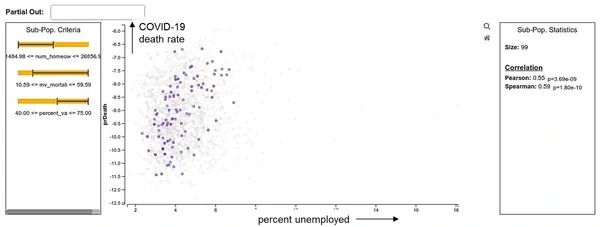COUNTIES WITH HIGH COVID-19 RISK: SET #5

Zooming in: counties where risk grows with unemployment
This is another example of a pattern of counties where the COVID-19 death rate was consistently above US average, but also where a significant correlation with a county attribute existed.
This automatically extracted pattern reveals that there is a statistically significant linear relationship between county unemployment rate and death rate, but only for counties where the percent of home ownership is low, where the motor vehicle accident mortality rate of black residents is high (>10%), and where the vaccination rate for Hispanics is high (>40%).
The counties that fit this description are the purple points in the scatterplot on the left. Considering only these 99 counties raises the correlation to a moderate level of 55% . Recall that the correlation of this factor for all counties (grey points) as a whole is negligible.

The pattern indicates that the residents of these counties are typically urban dwellers in areas with fairly high racial diversity, but the pattern description is much more specific than that.
The map on the left shows the counties that fit this description. They differ in the unemployment rate; the higher the rate, the darker the color. And due to the correlation relationship we found, darker colors also denote higher COVID-19 death rates.
We observe the higher affected (dark blue colored) counties are primarily in downstate New York, Maryland, Rhode Island, North Carolina, Louisiana, and around lower Lake Erie.
While these have been widely reported in the News, our analysis explains at a deeper level the specific characteristics that are shared among all of them which, when coupled with high unemployment, can make them particularly vulnerable to COVID-19 mortality.
While there are other US counties that also incurred high COVID-19 death rates, they are not characterized in this way. They have other explanations which we have derived as well in our studies.
The residents of these counties likely have low-level jobs which do not allow them to simply “hunker down” at home and do their work online. Spending more time outside in the public increases their risk of virus infection with a possible fatal conclusion.
This relationship is further exacerbated by the existing unemployment levels, as expressed by the correlation which is part of the pattern.
Of course these are speculations at this point, requiring further research. But at least now we know where to look and explore. Insights of this nature can inform the allocation of COVID-19 testing kits, testing stations, primary care units, and others. They can also focus community guidance and health policy in general.
